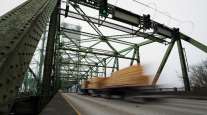Staff Reporter
South Dakota Approves 35 Grants for Local Bridge Improvements

The South Dakota Transportation Commission has approved 35 bridge improvement grants totaling more than $1.3 million.
The Preliminary Engineering Bridge Improvement Grants, known as BIG, which help transportation officials determine possible replacement structures, received $15 million this fiscal year. The grants were dispersed across 21 municipalities, some of which received more than one award.
South Dakota ranks No. 4 on the American Road and Transportation Builders Association’s list of states with the highest number of structurally deficient bridges as a percentage of total inventory. The group reported that 1,081 of the state’s 5,818 bridges are structurally deficient.

Kinniburgh
The remaining $13.7 million will be used for preservation, rehabilitation and full replacement grants, slated for approval by April.
Doug Kinniburgh, who manages the South Dakota Department of Transportation’s local government assistance and oversees BIG, said this is the first year in which the program’s sum has reached $15 million. The program is in its fourth year.
The bridges that received grants through BIG can accommodate cars and trucks, and must meet the state and federal definitions of a bridge. One factor is that the structure must have at least a 20-foot opening, according to Kinniburgh.
Because the bridges treated through the grant program are local bridges, Kinniburgh said they are of special importance to shorthaul truckers carrying crops and produce to stores for the state’s important agriculture industry. According to the U.S. Department of Agriculture, South Dakota specializes in growing oats, honey, wheat and corn.
“Some of [the bridges] might be considered important for freight movement,” Kinniburgh said. “They’re probably more important in the trucking industry for farm-to-market access.”
Kinniburgh said some of the smaller local bridges are load posted, meaning they bear signs dictating how much weight they can accommodate. He said trucks diverted away from these types of bridges generally flow into larger routes and can sometimes exacerbate congestion.
“The other impacts that maybe some of the over-the-road truckers see is that, as the vehicles can’t cross over these bridges, they go those other routes where it adds a little bit more congestion, a little more traffic to the route they’re using, as well,” Kinniburgh said.
BIG Grants by Transport Topics on Scribd
Union County, which stretches north of Sioux City, Iowa, at the southeastern tip of South Dakota, was awarded five grants, the most of any other county. Union County Highway Department Superintendent Jerry Buum said that some of the county’s bridges have heavy traffic, and estimated that 90% of the freight moved along these bridges are loads going from farms to markets.
Buum said the grants were important for repairing aging infrastructure, an issue he said extended to more than just Union County residents.
“We’ve identified our bridges and hopefully we get them replaced,” Buum said. “We’re in the same boat as everybody else.”
Kinniburgh said state officials try to remain consistent with maintenance and repair efforts for bridges.
“That’s been a big benefit of this whole program,” Kinniburgh said. “We are starting to see a little bit of an improvement. It’s at least headed in the right direction.”



